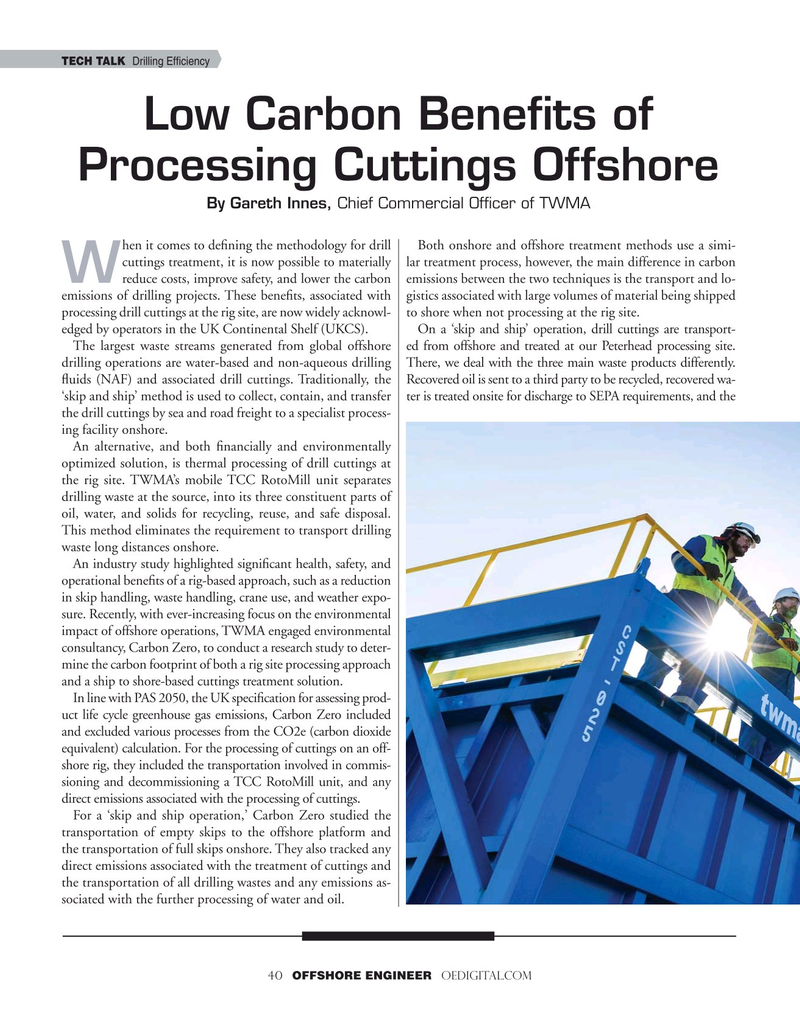
Page 40: of Offshore Engineer Magazine (Jul/Aug 2020)
Read this page in Pdf, Flash or Html5 edition of Jul/Aug 2020 Offshore Engineer Magazine
TECH TALK Drilling Ef?ciency
Low Carbon Benefits of
Processing Cuttings Offshore
By Gareth Innes, Chief Commercial Officer of TWMA hen it comes to de?ning the methodology for drill Both onshore and offshore treatment methods use a simi- cuttings treatment, it is now possible to materially lar treatment process, however, the main difference in carbon
W reduce costs, improve safety, and lower the carbon emissions between the two techniques is the transport and lo- emissions of drilling projects. These bene?ts, associated with gistics associated with large volumes of material being shipped processing drill cuttings at the rig site, are now widely acknowl- to shore when not processing at the rig site.
edged by operators in the UK Continental Shelf (UKCS). On a ‘skip and ship’ operation, drill cuttings are transport-
The largest waste streams generated from global offshore ed from offshore and treated at our Peterhead processing site. drilling operations are water-based and non-aqueous drilling There, we deal with the three main waste products differently. ?uids (NAF) and associated drill cuttings. Traditionally, the Recovered oil is sent to a third party to be recycled, recovered wa- ‘skip and ship’ method is used to collect, contain, and transfer ter is treated onsite for discharge to SEPA requirements, and the the drill cuttings by sea and road freight to a specialist process- ing facility onshore.
An alternative, and both ?nancially and environmentally optimized solution, is thermal processing of drill cuttings at the rig site. TWMA’s mobile TCC RotoMill unit separates drilling waste at the source, into its three constituent parts of oil, water, and solids for recycling, reuse, and safe disposal.
This method eliminates the requirement to transport drilling waste long distances onshore.
An industry study highlighted signi?cant health, safety, and operational bene?ts of a rig-based approach, such as a reduction in skip handling, waste handling, crane use, and weather expo- sure. Recently, with ever-increasing focus on the environmental impact of offshore operations, TWMA engaged environmental consultancy, Carbon Zero, to conduct a research study to deter- mine the carbon footprint of both a rig site processing approach and a ship to shore-based cuttings treatment solution.
In line with PAS 2050, the UK speci?cation for assessing prod- uct life cycle greenhouse gas emissions, Carbon Zero included and excluded various processes from the CO2e (carbon dioxide equivalent) calculation. For the processing of cuttings on an off- shore rig, they included the transportation involved in commis- sioning and decommissioning a TCC RotoMill unit, and any direct emissions associated with the processing of cuttings.
For a ‘skip and ship operation,’ Carbon Zero studied the transportation of empty skips to the offshore platform and the transportation of full skips onshore. They also tracked any direct emissions associated with the treatment of cuttings and the transportation of all drilling wastes and any emissions as- sociated with the further processing of water and oil. 40 OFFSHORE ENGINEER OEDIGITAL.COM

 39
39

 41
41